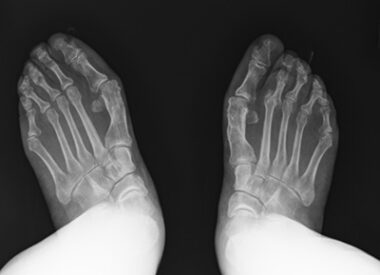Addressing my increasing concerns about lower leg edema
Despite kidney disease and high BP, I'm doing my best to maintain my health
Written by |

Chronic lower extremity edema is common among people with Fabry disease. This type of swelling occurs because of fluid buildup and may range from mild to pitting — when the swollen skin is pressed and an indentation remains.
Before I began receiving intravenous enzyme replacement therapy (ERT) for Fabry in a 2002 clinical trial, the edema in my legs, feet, and ankles was severe. I developed varicose veins and cracked, tight skin and faced a higher risk of infection.
Within a year of receiving ERT every two weeks, my edema improved significantly. Because my lower legs were smaller, I was able to start wearing compression socks to reduce the swelling further. However, the edema never disappeared entirely, and I still deal with it today.
After 23 years of ERT infusions, eating a healthy, low-sodium diet, walking and exercising more frequently, wearing firm compression socks daily, and undergoing a heart transplant in 2020 that improved my circulation, I’m concerned that the edema is lingering. I seem to have reached a limit in what I can do to manage it. My ankles and feet have also developed some mild discoloration, which worries me.

The author was surprised to discover he had a dislocated toe. (Courtesy of Jerry Walter)
I have seen many reports on social media of people with Fabry having their feet and lower legs amputated, many without diabetes. I wish to avoid this outcome by managing my lower leg edema as well as my chronic kidney disease (CKD), which could be partly responsible for the former. I want to maintain the best health possible.
Years of ERT infusions meant my CKD was stable at stage 3b. After my heart transplant, it improved to stage 2. However, in the past year, two of my urine tests have indicated increased kidney damage. My albumin-creatinine ratio, which should be less than 30 mg/g, is 600. And my protein-creatinine ratio — typically less than 0.2 mg/mg in adults — is 1.1.
At the same time, my blood pressure (BP) has been trending upward and now averages 130/90 mmHg. Chronic high BP can damage the kidneys. To address both my higher BP and increased urine ratio values, my nephrologist prescribed 40 mg of telmisartan (also known by its brand name, Micardis). It’s an angiotensin II receptor blocker that works to lower blood pressure.
For further reassurance that I’m protecting myself adequately, I visited a vascular specialist and a podiatrist, who both verified that I have adequate circulation in my legs and feet. The podiatrist discovered that the second toe on my right foot is dislocated. I was unaware. I suppose with the many manifestations of Fabry, it’s easy to miss lesser problems.

Jerry Walter uses his electric foot massager to improve circulation. (Courtesy of Jerry Walter)
To avoid additional lower extremity issues that could necessitate amputation, I plan to do the following:
- Ask my doctors to check the pulse in my lower extremities more often to ensure I’m maintaining adequate blood flow.
- Continue to eat healthily, avoid added sugar and salt, and drink several tablespoons of olive oil a day as instructed by my neurologist to keep my cholesterol and A1C low.
- Stay hydrated. I start my day by drinking a 16.9-ounce bottle of water, followed by several more bottles throughout the day.
- Exercise daily, including prescribed physical therapy exercises, stair-climbing, pushups, and moderate weight training.
- Go for a brisk 30-minute walk each day.
- Sleep for six to eight hours a night.
- Continue wearing compression socks daily to control lower leg edema.
- Use my electric foot massager once or twice a day for 15 minutes to improve blood flow in my feet and ankles.
I hope I can continue to meet the seemingly never-ending challenges of living with Fabry disease and that my experience can help others!
Note: Fabry Disease News is strictly a news and information website about the disease. It does not provide medical advice, diagnosis, or treatment. This content is not intended to be a substitute for professional medical advice, diagnosis, or treatment. Always seek the advice of your physician or other qualified health provider with any questions you may have regarding a medical condition. Never disregard professional medical advice or delay in seeking it because of something you have read on this website. The opinions expressed in this column are not those of Fabry Disease News or its parent company, Bionews, and are intended to spark discussion about issues pertaining to Fabry disease.







Nadine Brantley
I have been receiving Fabrazyme for about 20 years and have had edema off and on all of those years. I have tried all of the usual remedies you have mentioned. Finally this spring I couldn't bring it down and at my cardiology appt. the Dr prescribed Lasix 20 mg once per day and that brought the swelling down. My blood pressure has been in the perfect range since then. Before that it was a little high.
Deb Lee
Jerry, thanks for sharing your health updates and plans. Just wanted to say that it is best for people with edema to see the right doctors as you did. I had similar edema in my feet and pulses were hard to detect in the feet. I tried using compression stockings and they were painful. After having a Ankle-Brachial Index test, it was determined I had leg claudication caused by Peripheral Artery Disease. I was told that I should never use compression stockings. I am doing as you suggested - exercise, hydrating, sleeping and eating right. You're an inspiration - may you live long!
Ann Page
Jerry thank you so much for sharing your life with Fabry with us. I'm a physical therapist in Canada with Fabry. Wondering if your type of leg edema could be treated with manual lymph drainage (MLD)? It's a very specific type of massage that requires extra training. I've referred many of my patient's for this treatment. Post mastectomy, post ankle fracture, post total knee replacement - all benefit. There are also methods of taping with k-tape that can help. Registered massage therapists or a cancer clinuc might have information on what or who is available near you. Good luck!
Kara bakke
I am not a fan of these personal pieces as it is not possible for many Fabry patients to get a heart transplant. I am hoping you can have a medical article that addresses the edema.
1: have a family member check your pulses. Communicate edema and numbness/tingling to your care provider immediately. Sores and open wounds on lower extremities need to also be communicated immediately.
2: Not everyone is capable of a 30 minute brisk walk. What other things can people do? Some people have already lost toes and feet and legs. Good for Jerry but not empathetic to others suffering. I have family members in their 30s who have had amputations due to no fault of their own. Jerry has been lucky,
3: is the edema related to kidney failure? Heart failure? Or is it fabry specific? That is the article I want to read. How do we address it differently if it is fabry specific?
4: is there research that an electronic foot massager is indicated? Many people with fabry have neuropathy and it seems that this kind of device could do more harm than good.
I think that you need to have a medical professional review these pieces before you publish them. I would not have read this if I had known it was just another personal
Story.